Elster Solutions VRT03 Pit Water Meter Transponder User Manual CERTIFICATE OF COMPLIANCE
Elster Solutions, LLC Pit Water Meter Transponder CERTIFICATE OF COMPLIANCE
Users Manual

Rhein Tech Laboratories AMCO Automated Systems
360 Herndon Parkway
Suite 1400
Pit Water-Meter Transponder
FCC ID: G8JVRT03
Herndon, VA 20170 FCC Part 15.231
http://www.rheintech.com RTL WO# 2003005
Page 23 of 29
APPENDIX H: MANUAL
Please see the following pages.

U
U
US
S
SE
E
ER
R
R
G
G
GU
U
UI
I
ID
D
DE
E
E
TRACE ™
P
Pi
it
t
W
Wa
at
te
er
r-
-
M
Me
et
te
er
r
T
Tr
ra
an
ns
s
p
p
o
on
nd
de
er
r
Copyright Acknowledgements
The contents of this document are the property of AMCO
Automated Systems and are copyrighted. All rights reserved.
Any reproduction, in whole or in part, is strictly prohibited. For
additional copies of this document, please contact:
AMCO Automated Systems
107 Erskine Lane
Scott Depot, WV 25560
Phone 304-757-3300 Fax 304-757-3388
The information contained herein has been carefully checked
and is believed to be accurate; however, no responsibility is
assumed for inaccuracies. AMCO Automated Systems reserves
the right to make changes without prior notice. This document is
not covered by any warranty either expressed or implied. Any
correction, comments or additions to the contents of this
document should be directed to AMCO Automated Systems at
the above address.
Copyright 2002 AMCO Automated Systems. Printed in USA.
TRACE, Universal RF Interface, URFI, Mini Mobile Interrogator,
ReadIt and TICS are trademarks of AMCO Automated Systems.
All rights reserved.
MS-DOS, IBM and MicroPalm are registered trademarks of their
respective owners.
FCC Compliance
The TRACE VRT Transponder™ has been type accepted by the
Federal Communications Commission under Part 15C, low
power communication device transmitter. The FCC ID for the Pit
Water Transponder (PWT) is G8JVRT03, and the FCC ID for the
Remote Water Transponder (RWT) is G8JVRT02.
This device complies with Part 15 rules. Operation is subject to
the following conditions:
1. This device may not cause harmful interference, and
2. This device must accept any interference received, including
interference that may cause undesired operation.
This equipment has been tested and found to comply with the
limits for a Class B digital device, pursuant to part 15 of the FCC
Rules. These limits are designed to provide reasonable
protection against harmful interference in a residential
installation. This equipment generates, uses and can radiate
radio frequency energy, and if not installed and used in
accordance with the instructions, may cause harmful interference
to radio communications. However, there is no guarantee that
interference will not occur in a particular installation. If this
equipment does cause harmful interference to radio or television
reception, which can be determined by turning the equipment off
and on, the user is encouraged to try to correct the interference
by one or more of the following measures:
• Reorient or relocate the receiving antenna.
• Increase the separation distance between the
equipment and receiver.
• Connect the equipment into an outlet on a circuit
different from that to which the receiver is
connected.
• Consult the dealer or an experience radio/TV
technician for help.
Changes or modifications not expressly approved by AMCO
Automated Systems could void the user’s authority to operate
the equipment.

TABLE OF CONTENTS
VRT Transponder—User Guide Page 1
AMCO Automated Systems, January 2003 Last Saved: 1/28/2003 10:00 AM
Pit Water-Meter Transponder
Manual and Installation Guide
Table of Contents
Chapter One—Introduction................................................................................. 2
About this Document ....................................................................................... 2
Audience ................................................................................................... 2
Conventions .............................................................................................. 2
Chapter Two—Automated Meter Reading Overview........................................ 3
Basic AMR Components ................................................................................. 3
TRACE AMR System Overview ...................................................................... 4
Chapter Three—Pit Water-Meter Transponder Overview ................................ 6
VRT Water Transponder and Components..................................................... 6
How the VRT Water Transponder Works........................................................ 7
Specifications .................................................................................................. 8
Chapter Four—Pit Water-Meter Transponder Installation and Programming9
Installation ....................................................................................................... 9
Programming ................................................................................................... 9
Chapter Five—Troubleshooting ....................................................................... 11

INTRODUCTION
VRT Transponder—User Guide Page 2
AMCO Automated Systems, January 2003 Last Saved: 1/28/2003 10:00 AM
Chapter One
Chapter OneChapter One
Chapter One
Introduction
The TRACE® VRT Transponder is the heart of AMCO Automated
Systems’ portfolio of products for automated meter reading (AMR).
About this Document
The Transponder manual and installation Guide provides instructions for
installing and troubleshooting transponders. It also includes an overview
of both AMR in general and TRACE technology in particular.
Audience
This document is designed for utility industry meter readers and
supervisory staff. In order to establish appropriate levels of detail for the
material, this document assumes the following:
The user is proficient in reading meters of the type currently
compatible with TRACE transponders and possesses all the skills
necessary to conduct meter reading by conventional means.
The user has little or no prior expertise in the TRACE AMR
technology.
The user is familiar with common data entry devices and techniques.
Conventions
In the interest of brevity and simplicity, this document uses the following
conventions:
Additional information relevant to a given instruction step may be
shown in one of three ways:
1. A bulleted item covers “how-to” and verification information.
2. An italicized NOTE contains relevant background information.
3. An italicized and bolded CAUTION contains information
important to the safety of either the user or the equipment.
Where reference to other parties is made, the generic masculine
pronouns (he, his, him) are used. This is no way reflects bias or
gender discrimination in any manner related to the users, publishers
or authors of this document.
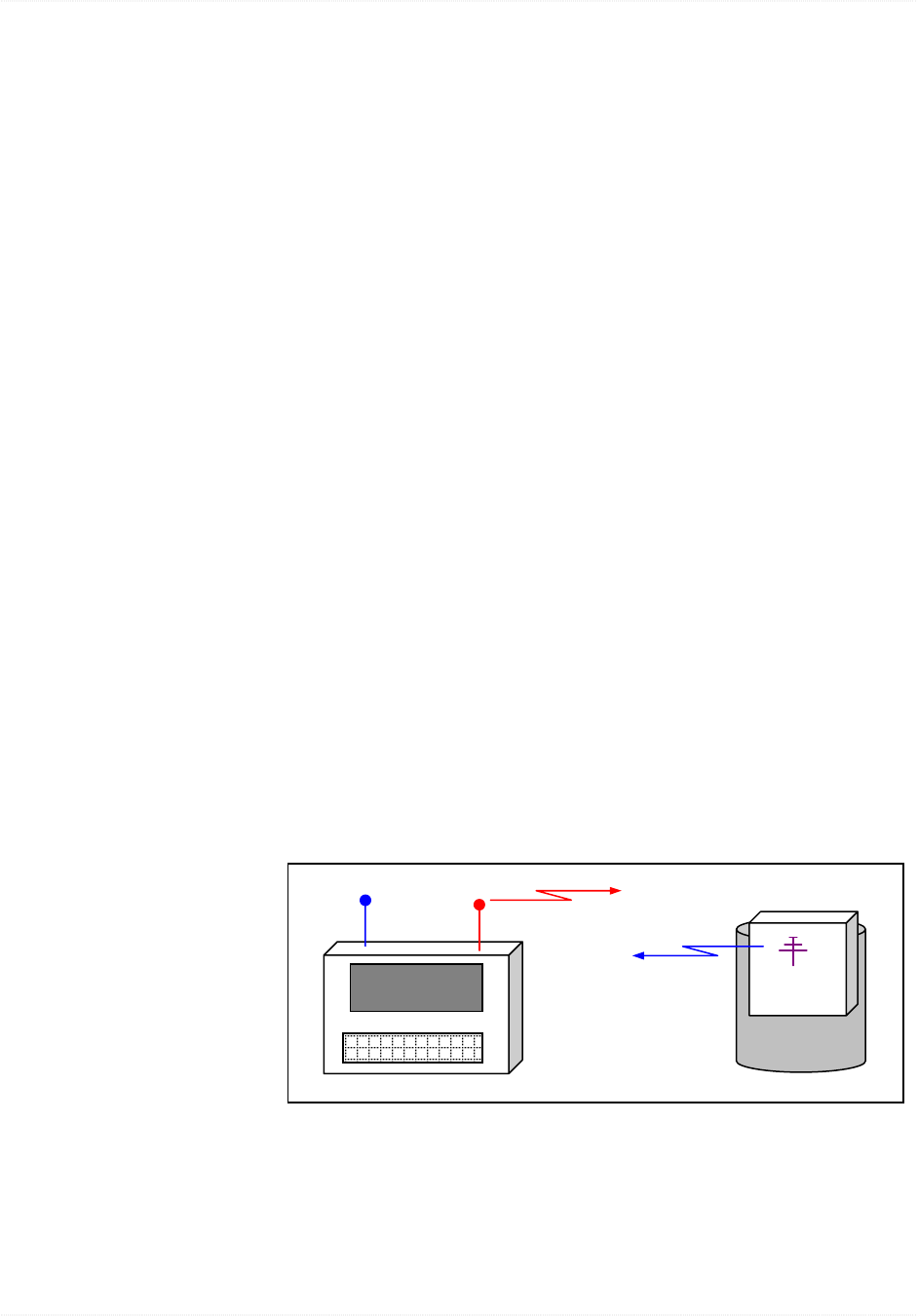
AMR OVERVIEW
VRT Transponder—User Guide Page 3
AMCO Automated Systems, January 2003 Last Saved: 1/28/2003 10:00 AM
Chapter Two
Chapter TwoChapter Two
Chapter Two
Automated Meter Reading Overview
The TRACE system uses radio frequency (RF) signals to allow utility
personnel to read meters from a distance while the reader is in motion.
This technology is called automated meter reading (AMR). This
technology greatly increases the speed at which routes can be covered
with a high degree of accuracy.
Basic AMR Components
An automated meter reading system requires the following basic
components:
Transponder—The transponder interfaces with the water meter
register/encoder to capture water usage data, receives commands
from an interrogator and transmits the water usage data.
Interrogator—At its simplest, the interrogator remotely reads meter
data transmitted by transponders. At more sophisticated levels an
interrogator may also program transponders, store route data, “wake
up” transponders, and verify transponder conditions, among other
functions.
Antennas—Both the transponder and the interrogator use antennas
to broadcast and receive RF signals. The transponder’s antenna is
typically located inside the transponder case. Some interrogators use
external antennas (as shown in the illustration below), one for
transmitting and one for receiving. Many handheld interrogators use
a single antenna for both transmitting and receiving (antenna may be
internal or external).
Transponder
METER
The interrogator sends out an RF signal to the desired transponders. Upon receiving an authorized
command the transponder transmits its stored meter data.
S/N 6501529
234 Maple D
rive
Interrogator
Interrogator transmits commands
& queries to transponder(s)
Transponder transmits
meter data to the
interrogator’s receiver
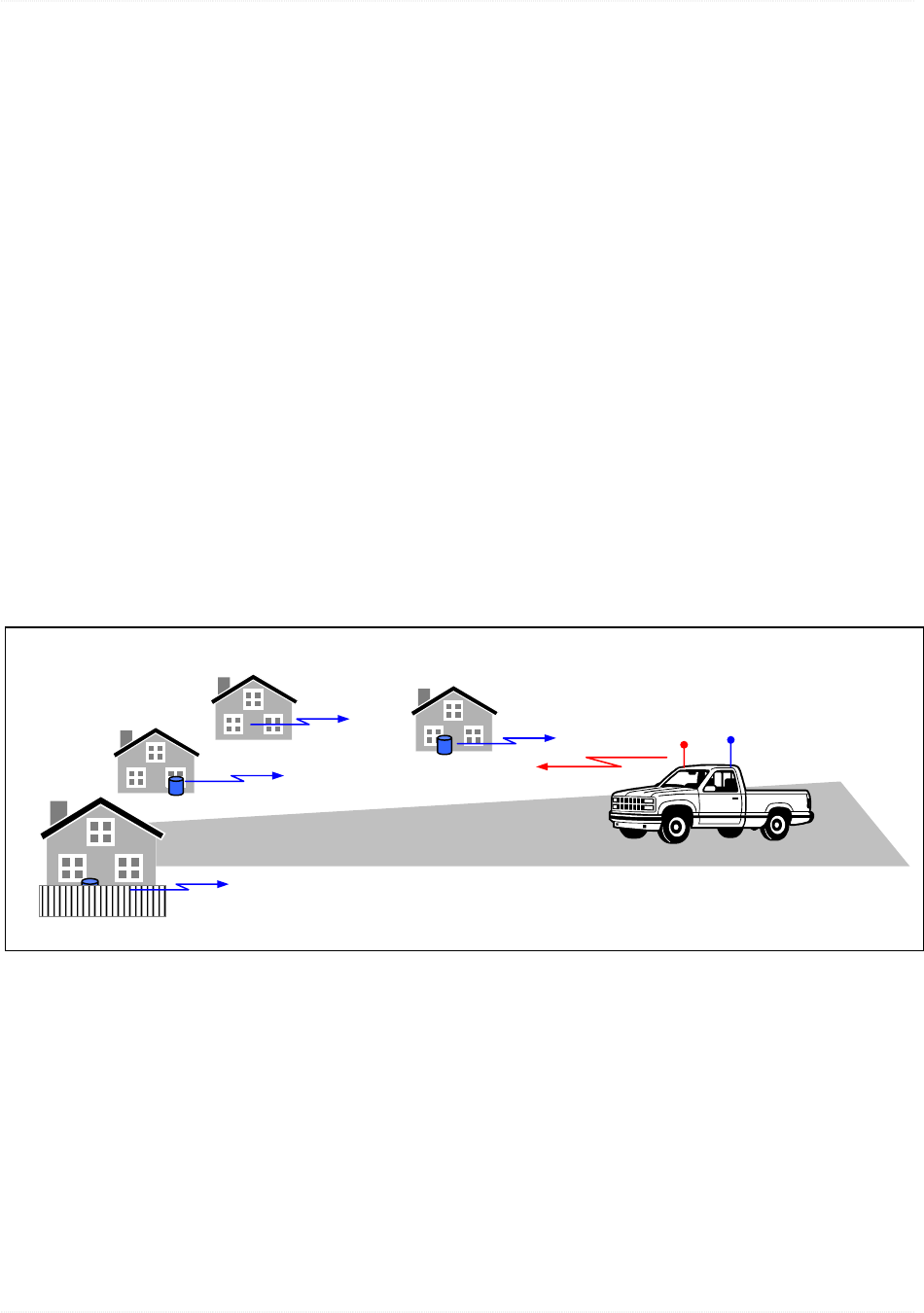
TRACE SYSTEM OVERVIEW
VRT Transponder—User Guide Page 4
AMCO Automated Systems, January 2003 Last Saved: 1/28/2003 10:00 AM
The TRACE AMR System Overview
In addition to standard automated meter reading functions, AMCO’s
TRACE system portfolio of products permits the remote recording of
tamper conditions and linking of meter latitude and longitude data using
a Global Positioning System (GPS) receiver. With the optional Vehicle
Interactive Display, TRACE makes driver-to-meter orientation more
intuitive and efficient.
TRACE interrogators transmit at 451.35 MHz and receive transponder
messages at 415 MHz. (Transponders transmit at 415 MHz and receive
at 451.35 MHz.)
Trace water transponders listen for an interrogation signal once every
1.5 seconds. Only if a transponder hears its unique serial number will it
transmit data back to the interrogation device.
How the TRACE System Works
Utility personnel no longer have to walk up to each meter, look at its
index and record its reading. Once transponders are installed on meters
and programmed, meter readers simply walk or drive down each street in
the route allowing the TRACE interrogator to request and record meter
data automatically.
Acquisition of meter information begins with the transponder where data
is stored continuously for later retrieval and moves to the interrogator
upon command. The acquired data from a given route can be transferred
to a host computer via floppy disk for processing.
The information acquisition, storage and handling process includes
several basic elements:
Meter interface. The TRACE VRT water transponder queries the water
meter register/encoder and stores it in the transponder’s memory.
SN 1111 Read 208…
SN 2222 Read 943…
MMI
Equipped
SN 3333 Read 510…
SN 4444 Read 1031…
TRAN
S
MIT
RECEIVE
The interrogator addresses each transponder in the interrogation window individually. When the transponder “hears” its serial number and proper authorization, it
transmits the current meter data. The TRACE system’s frequency band allows remote reading of transponders even through walls and fences.

TRACE SYSTEM OVERVIEW
VRT Transponder—User Guide Page 5
AMCO Automated Systems, January 2003 Last Saved: 1/28/2003 10:00 AM
Transponder data acquisition. The transponder is programmed with a
unique serial number at the time of manufacture. The transponder
queries the water meter register/encoder and stores this reading in
memory.The transponder also records changes to the tamper detection
sensor.
Route information loading. Route data includes meter account number,
address and latitude/longitude coordinates (when available), and
transponder serial number. This information, along with Guide and Start
files, is downloaded to the interrogator prior to commencing automated
meter reading. By also tracking the vehicle or interrogator’s coordinates,
a GPS-equipped system determines which transponders in the route
should lie within range at any given time and transmits those serial
numbers requesting meter data.
Interrogation. Once placed in an interrogation mode by the meter
reader, the TRACE interrogator transmits serial number(s) of the desired
transponder(s) along with a command requesting the contents of each
transponder’s memory. Transponders are selected for reading on the
basis of route and meter location information stored in the interrogator
and presence of the transponder within range of the interrogator.
Route data processing. Meter data from transponders is stored in the
interrogator’s memory and can be transferred to the utility’s host
computer for processing
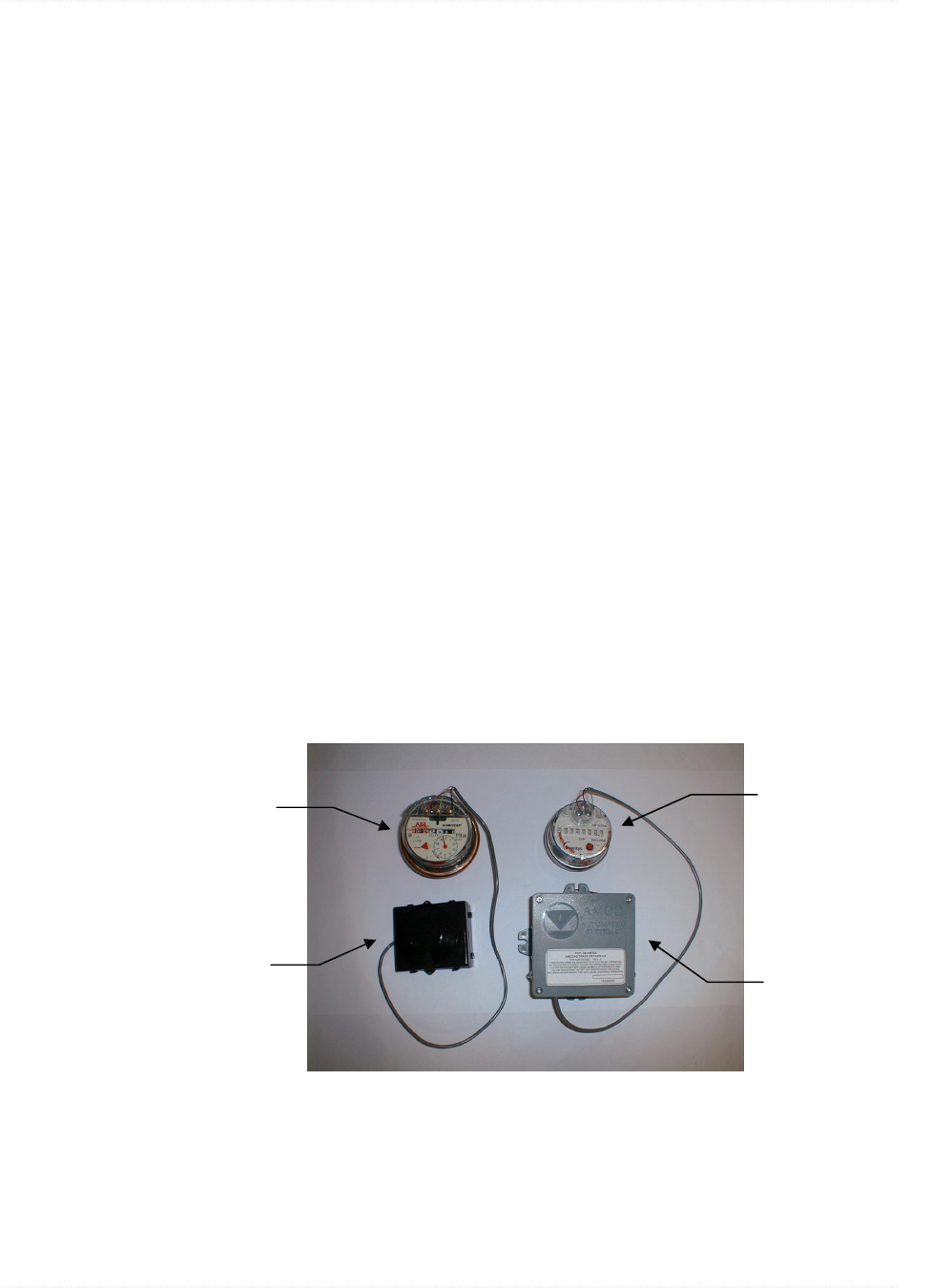
VRT TRANSPONDER OVERVIEW
VRT Transponder—User Guide Page 6
AMCO Automated Systems, January 2003 Last Saved: 1/28/2003 10:00 AM
Chapter Three
Chapter ThreeChapter Three
Chapter Three
Pit Water-Meter Transponder Overview
The TRACE VRT Water Transponder is designed for use with most
water meters from AMCO Water Metering System, Badger, Sensus, and
Neptune. The transponder maintains the current time and date, which
are used to record real-time data for retrieval as required during the
normal read cycle. In addition to maintaining an electronic index (e-
index) reading that corresponds to the meter index reading, the
transponder:
• Stores 35 daily index readings in separate e-indexes recorded at the
start of the utility day.
• Maintains up to four time-of-use (TOU) e-indexes that each have
programmable start and stop times.
Pit Water-Meter Transponder and Components
The transponder consists of a high impact plastic housing; RF
transmitter; receiver; tamper detection; transmit and receive antennas;
battery, and various electronic components.
The transponder is shipped with mounting hardware.
Pit Water
Transponder
(PWT)
Water Meter
Re
g
ister/Encoder
Remote Water
Transponder
(RWT)
Water Meter
Register/Encoder

VRT TRANSPONDER OVERVIEW
VRT Transponder—User Guide Page 7
AMCO Automated Systems, January 2003 Last Saved: 1/28/2003 10:00 AM
How the Pit Water Transponder Works
The transponder polls the water meter register/encoder for the meter
reading and stores this value in the transponder’s memory. The interval
at which the transponder polls the register/encoder is referred to as the
encoder latency and is programmable by the user. The default value for
the encoder latency is 1 hour. When the transponder receives an
interrogation signal, the transponder transmits the latest meter reading
stored in memory to the interrogator.
Once a day, at a pre-programmed time, the transponder stores the
current index reading for that day into the e-index for that day. The
transponder maintains daily reading history for the past 35 days. Four
time-of-use registers with programmable start and stop times can
accumulate consumption in separate e-indexes as well.
To maximize battery life, the transponder changes from its normal, low-
power quiescent state every 1.5 seconds into an intermediate power
state for 2.5 milliseconds in order to (1) update the e-index for the meter
index, daily reading and time-of-use indexes; perform tamper detection;
and (3) check to see if a valid interrogation signal is being received.
When a valid interrogation signal (including the transponder’s unique
serial number) is received, a two-way communication link is established.
A current reading and other historical data (as required for each
individual account) is transmitted to the interrogator. Data collected by
an interrogator are validated, audited and stored for uploading to
TRACE® Route Manager VRT Software later.
VRT™ Transponder Program Values.
At the time of manufacture transponders are programmed with the
current date, time of day, and other values as specified by the utility.
Time of Day. The time of day for the time zone specified by the utility is
programmed into the transponder. The time of day on the transponder
can be synchronized with the clock in the interrogation device each time
the transponder is read.
Daylight Savings Time. If daylight savings time is observed the utility
must advise AMCO Automated Systems and the initial settings will be
programmed into the transponder at the time of manufacture. Updates
to daylight savings time will be communicated through Route Manager
VRT ™ and interrogators.
Daily Read Capture Time. Daily read history is recorded at the same
time each day for retrieval at a later date. The daily read capture time is
specified by the utilty and programmed into the transponder at time of
manufacture.
Time of Use Registers. Time of use registers, if activated, accumulate
consumption recorded by the transponder between the start and stop
time set for each TOU register. If activated the TOU register must be
active for a minimum of 00:29:59 (hh:mm:ss) and a maximum of
23:44:59 (hh:mm:ss). TOU registers can start on the hour or in 15-
minute intervals after the hour (12:15:00 PM is a valid start time /

VRT TRANSPONDER OVERVIEW
VRT Transponder—User Guide Page 8
AMCO Automated Systems, January 2003 Last Saved: 1/28/2003 10:00 AM
12:07:00 PM is not a valid time). TOU registers must end at the end of
the hour or in 15-minute intervals thereafter (01:59:59 PM is a valid stop
time / 02:13:59 is not). TOU registers can overlap – for example, TOU
01 can run from 08:00:00 AM until 10:29:59 PM and TOU 02 can run
from 10:15:00 AM until 2:29:59 PM. TOU registers can span midnight –
a start time of 08:00:00 PM with a stop time of 01:59:59 AM is valid.
Leak Detect. TBD
Leak Interval. TBD
Leak Consumption. TBD
Meter Type. TBD
Specifications
The following table shows the Pit Water-Meter Transponder
specifications. The specifications given below apply to both the Remote
Water and the Pit Water transponders, except where specifically noted.
Power One (1) lithium – Thionyl chloride 2750 mAmp-hours; 20 years calculated life
under normal working conditions. The battery can be easily replaced in the
field.
FCC Compliance Part 15, Subpart C: a user license is not required
FCC ID G8JVRT02 (Remote Water Transponder)
FCC ID G8JVRT03 (Pit Water Transponder)
RF Transmitter 414.5 MHz, +.0.5, -1.0 MHz; 4,000 uV/m @ 3m.
RF Receiver 451.35 MHz; -70 dBm sensitivity
Materials • Housing: high-impact plastic, weatherproof, UV protected for outdoor
installation.
• Circuit-card assembly: conformal-coated
• Corrosion–protected external-housing screws
• Circuit-card encapsulated in weatherproofing gel (Pit Water Transponder)
Operating Temperature
Range -22°F to 158°F (-30°C to 70°C)
Storage Temperature
Range
-40 °F to 185°F (-40°C to 85°C)
Humidity 5-95% Relative (non-condensing)
Weight 12 oz. fully assembled (Remote Water Transponder)
8 oz. fully assembled (Pit Water Transponder)
Serial Numbers Up to eight digits, starting at 6500000

VRT WATER TRANSPONDER INSTALLATION & PROGRAMMING
VRT Transponder—User Guide Page 9
AMCO Automated Systems, January 2003 Last Saved: 1/28/2003 10:00 AM
Chapter Four
Chapter FourChapter Four
Chapter Four
Pit Water-Meter Transponder Installation &
Programming
Installation
For proper installation of the transponder onto the water meter, please
contact the manufacturer of the water meter register/encoder.
Programming
Please refer to the SRP manual for programming instructions, if required.
1. Current Date
This value is programmed at the factory, but will be lost in the event
of a power interruption. If necessary, program the transponder with
the current date.
2. Current Time
This value is programmed at the factory, but will be lost in the event
of a power interruption. If necessary, program the transponder with
the current time.
3. Daily Read Capture Time
This value is programmed at the factory and is retained in the event
of a power interruption. The value can be reprogrammed if your
requirements change.
4. Daily Read History
The value in each Daily Read e-index is recorded at a pre-
determined time every day and can be retrieved for up to 35 days. In
the event of a power interruption these values are lost and cannot be
retrieved.
5. Time of Use (TOU) e-index Parameters
There can be different values for each TOU e-index. These values
are programmed at the factory, but will be lost in the event of a
power interruption. If your requirements change the TOU start and
stop times can be reprogrammed at any time.
6. Time of Use (TOU) e-index Values
The value in each TOU e-index accumulates as the mechanical
index registers consumption. In the event of a power interruption the
values in each TOU e-index is lost and cannot be recovered.
7. Leak Detect
TBD
8. Leak Interval

VRT WATER TRANSPONDER INSTALLATION & PROGRAMMING
VRT Transponder—User Guide Page 10
AMCO Automated Systems, January 2003 Last Saved: 1/28/2003 10:00 AM
TBD
9. Leak Consumption
TBD
10. Meter Type
TBD
11. Next Daylight Saving Time Day Number
The transponder’s internal clock will automatically switch to daylight
saving time on the date represented by the value entered into this
field. The value must represent a future date. Please refer to table
[TABLE 01] for a list of valid entries. This value is programmed at
the factory for the next valid date after it is shipped, but must be
updated by the utility for subsequent periods. In the event of a
power interruption the value is retained.
12. Next Standard Time Number
The transponder’s internal clock will automatically switch to standard
time on the date represented by the value entered into this field. The
value must represent a future date. Please refer to table [TABLE 01]
for a list of valid entries. This value is programmed at the factory for
the next valid date after it is shipped, but must be updated by the
utility for subsequent periods. In the event of a power interruption
the value is retained.
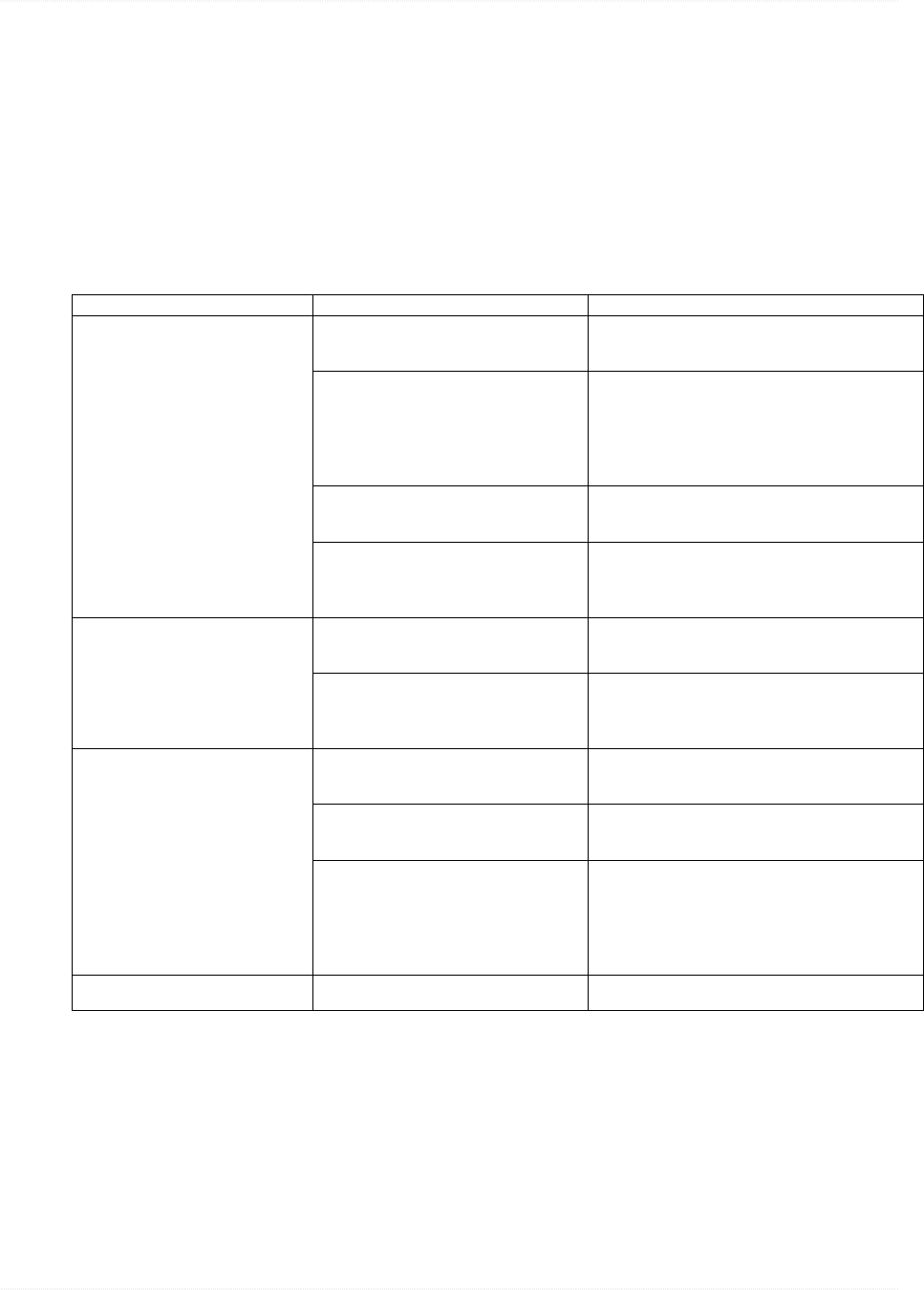
TROUBLESHOOTING
VRT Transponder—User Guide Page 11
AMCO Automated Systems, January 2003 Last Saved: 1/28/2003 10:00 AM
Chapter Five
Chapter FiveChapter Five
Chapter Five
Troubleshooting
The following table offers troubleshooting tips for some common
Transponder conditions. For all other matters, contact AMCO Automated
Systems.
Symptom Possible Cause Solution
The incorrect serial number has been
entered into the interrogator
Verify that the correct serial number is being
interrogated
The transponder is not within range of
the interrogation device
Be certain that the interrogator is within range of
the transponder. An SRP should be within 3
inches of the transponder. If operating an MMI in
Lat/Long or GEO Mode be certain that the
transponder is in the reading window.
Interference from another interrogation
device.
Verify that no other interrogations are taking
place, either with an SRP, PI, URFI, or MMI.
Transponder cannot be
interrogated with an SRP, MMI or
PI Device
Interference from another interrogation
device.
Any MMI within range of the transponder must
have the transmitter turned off while you are
interrogating with the SRP.
The SRP is out of range of the
transponder.
Move the SRP (and particularly the top, where
antenna resides) closer to the transponder.
Transponder will not program
The programming device (SRP, PI) is
attempting to communicate with the
incorrect transponder serial number
Correct the serial number in the programming
device.
Malfunctioning Interrogator Check operation of interrogator on known good
transponder
Interference from external sources Clear area around transponder of metal objects
(lawn chairs, bicycles, etc.).
Transponder will not read from
street
Hard-to-read location Place a known good transponder at the same
location and attempt to read both units from the
street. If the new unit will read replace the old unit
and reinstall it on a meter with shorter range
requirements.
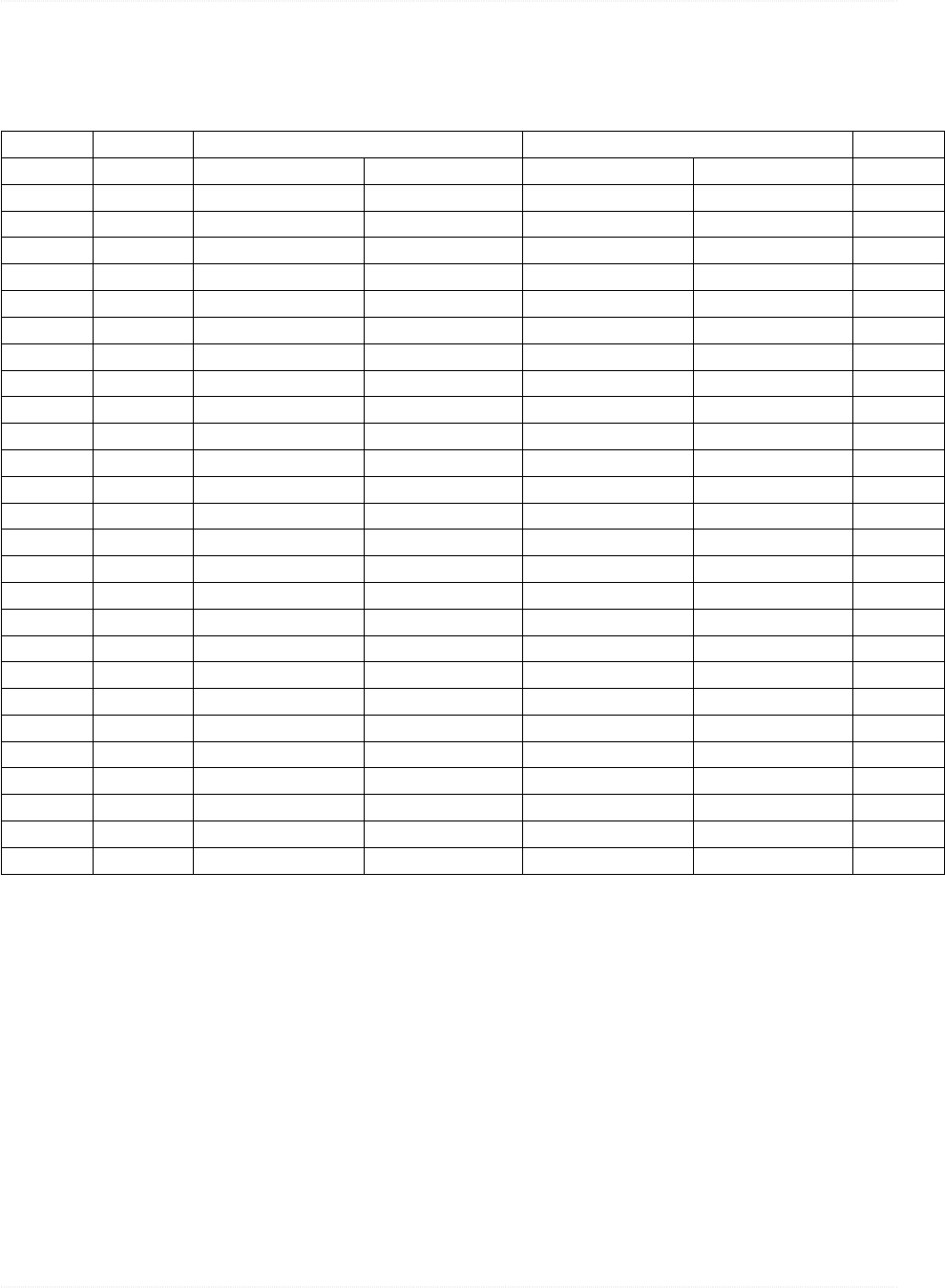
TROUBLESHOOTING
VRT Transponder—User Guide Page 12
AMCO Automated Systems, January 2003 Last Saved: 1/28/2003 10:00 AM
Table 01 - DST / ST Date Values
Daylight Saving Time Starts ST Starts
Year Date Day No. Date Day No.
2002 04/07/02 96 10/27/02 299
2003 04/06/03 460 10/26/03 663
2004 04/04/04 824 10/31/04 1034
2005 04/03/05 1188 10/30/05 1398
2006 04/02/06 1552 10/29/06 1762
2007 TBD TBD
2008 TBD TBD
2009 TBD TBD
2010 TBD TBD
2011 TBD TBD
2012 TBD TBD
2013 TBD TBD
2014 TBD TBD
2015 TBD TBD
2016 TBD TBD
2017 TBD TBD
2018 TBD TBD
2019 TBD TBD
2020 TBD TBD
2021 TBD TBD
2022 TBD TBD
2023 TBD TBD
2024 TBD TBD
2025 TBD TBD
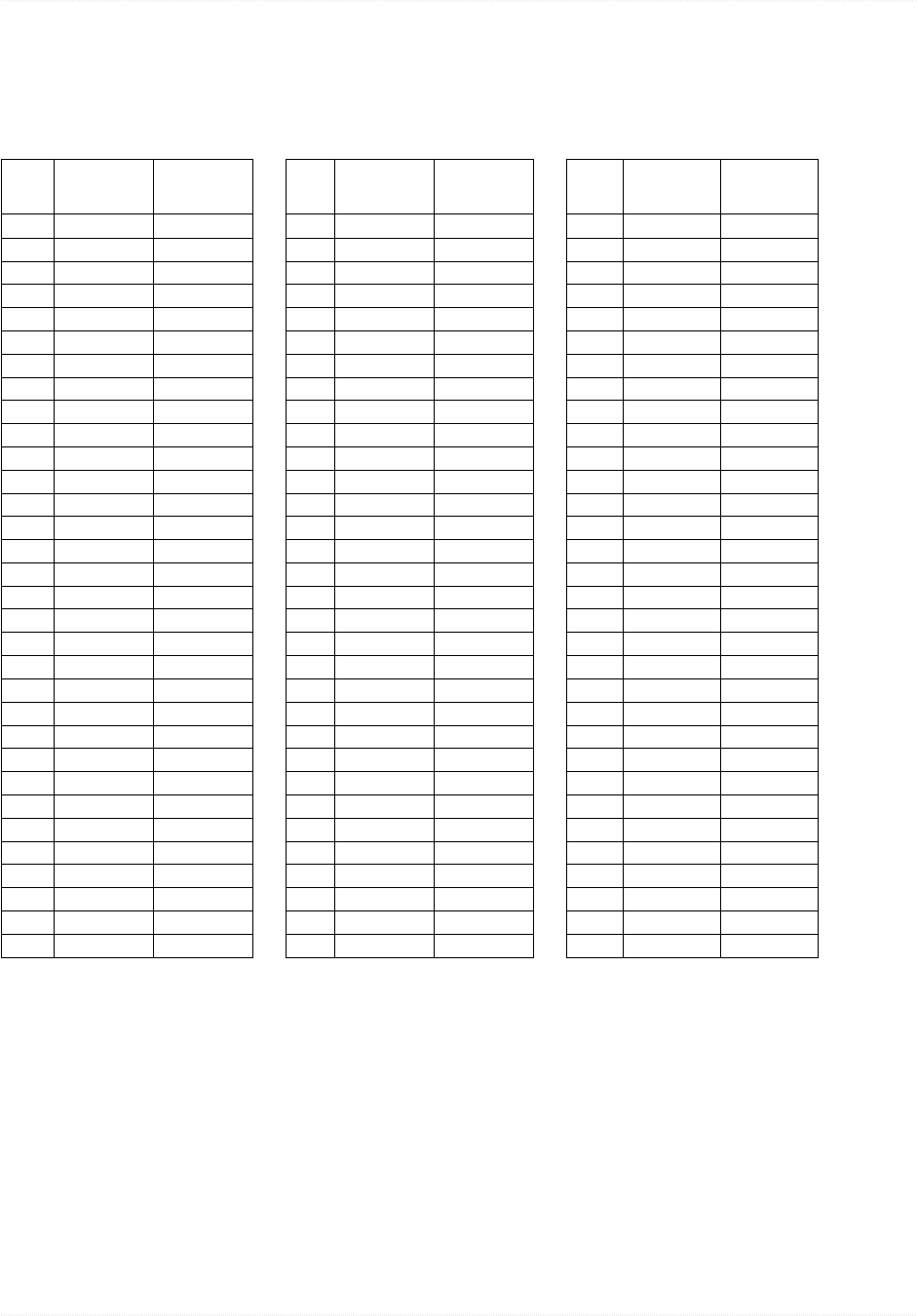
TROUBLESHOOTING
VRT Transponder—User Guide Page 13
AMCO Automated Systems, January 2003 Last Saved: 1/28/2003 10:00 AM
Table 02 - TOU Time Slots
Time
Slot
Start
Time
End
Time
Time
Slot
Start
Time
End
Time
Time
Slot
Start
Time
End
Time
1 12:00:00 AM 12:14:59 AM 33 8:00:00 AM 8:14:59 AM 65 4:00:00 PM 4:14:59 PM
2 12:15:00 AM 12:29:59 AM 34 8:15:00 AM 8:29:59 AM 66 4:15:00 PM 4:29:59 PM
3 12:30:00 AM 12:44:59 AM 35 8:30:00 AM 8:44:59 AM 67 4:30:00 PM 4:44:59 PM
4 12:45:00 AM 12:59:59 AM 36 8:45:00 AM 8:59:59 AM 68 4:45:00 PM 4:59:59 PM
5 1:00:00 AM 1:14:59 AM 37 9:00:00 AM 9:14:59 AM 69 5:00:00 PM 5:14:59 PM
6 1:15:00 AM 1:29:59 AM 38 9:15:00 AM 9:29:59 AM 70 5:15:00 PM 5:29:59 PM
7 1:30:00 AM 1:44:59 AM 39 9:30:00 AM 9:44:59 AM 71 5:30:00 PM 5:44:59 PM
8 1:45:00 AM 1:59:59 AM 40 9:45:00 AM 9:59:59 AM 72 5:45:00 PM 5:59:59 PM
9 2:00:00 AM 2:14:59 AM 41 10:00:00 AM 10:14:59 AM 73 6:00:00 PM 6:14:59 PM
10 2:15:00 AM 2:29:59 AM 42 10:15:00 AM 10:29:59 AM 74 6:15:00 PM 6:29:59 PM
11 2:30:00 AM 2:44:59 AM 43 10:30:00 AM 10:44:59 AM 75 6:30:00 PM 6:44:59 PM
12 2:45:00 AM 2:59:59 AM 44 10:45:00 AM 10:59:59 AM 76 6:45:00 PM 6:59:59 PM
13 3:00:00 AM 3:14:59 AM 45 11:00:00 AM 11:14:59 AM 77 7:00:00 PM 7:14:59 PM
14 3:15:00 AM 3:29:59 AM 46 11:15:00 AM 11:29:59 AM 78 7:15:00 PM 7:29:59 PM
15 3:30:00 AM 3:44:59 AM 47 11:30:00 AM 11:44:59 AM 79 7:30:00 PM 7:44:59 PM
16 3:45:00 AM 3:59:59 AM 48 11:45:00 AM 11:59:59 AM 80 7:45:00 PM 7:59:59 PM
17 4:00:00 AM 4:14:59 AM 49 12:00:00 PM 12:14:59 PM 81 8:00:00 PM 8:14:59 PM
18 4:15:00 AM 4:29:59 AM 50 12:15:00 PM 12:29:59 PM 82 8:15:00 PM 8:29:59 PM
19 4:30:00 AM 4:44:59 AM 51 12:30:00 PM 12:44:59 PM 83 8:30:00 PM 8:44:59 PM
20 4:45:00 AM 4:59:59 AM 52 12:45:00 PM 12:59:59 PM 84 8:45:00 PM 8:59:59 PM
21 5:00:00 AM 5:14:59 AM 53 1:00:00 PM 1:14:59 PM 85 9:00:00 PM 9:14:59 PM
22 5:15:00 AM 5:29:59 AM 54 1:15:00 PM 1:29:59 PM 86 9:15:00 PM 9:29:59 PM
23 5:30:00 AM 5:44:59 AM 55 1:30:00 PM 1:44:59 PM 87 9:30:00 PM 9:44:59 PM
24 5:45:00 AM 5:59:59 AM 56 1:45:00 PM 1:59:59 PM 88 9:45:00 PM 9:59:59 PM
25 6:00:00 AM 6:14:59 AM 57 2:00:00 PM 2:14:59 PM 89 10:00:00 PM 10:14:59 PM
26 6:15:00 AM 6:29:59 AM 58 2:15:00 PM 2:29:59 PM 90 10:15:00 PM 10:29:59 PM
27 6:30:00 AM 6:44:59 AM 59 2:30:00 PM 2:44:59 PM 91 10:30:00 PM 10:44:59 PM
28 6:45:00 AM 6:59:59 AM 60 2:45:00 PM 2:59:59 PM 92 10:45:00 PM 10:59:59 PM
29 7:00:00 AM 7:14:59 AM 61 3:00:00 PM 3:14:59 PM 93 11:00:00 PM 11:14:59 PM
30 7:15:00 AM 7:29:59 AM 62 3:15:00 PM 3:29:59 PM 94 11:15:00 PM 11:29:59 PM
31 7:30:00 AM 7:44:59 AM 63 3:30:00 PM 3:44:59 PM 95 11:30:00 PM 11:44:59 PM
32 7:45:00 AM 7:59:59 AM 64 3:45:00 PM 3:59:59 PM 96 11:45:00 PM 11:59:59 PM
Note: TOU registers cannot start and end with the same time slot.